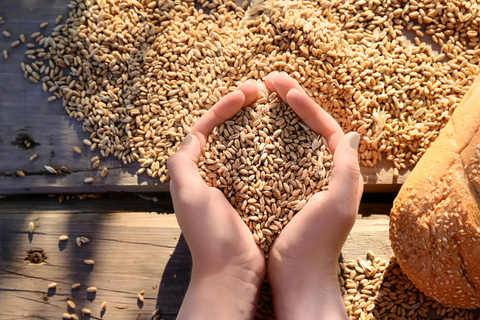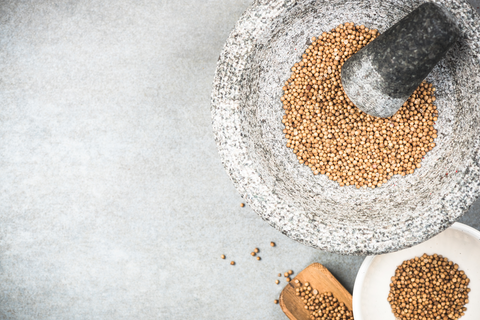Wheat berries have been used for centuries to make flour. A wheat berry is a whole wheat kernel, including the bran, germ, and endosperm. They contain essential nutrients and are usually ground to make flour. While you can find the ground version at your superstore, it's even more fun when you grind them yourself. In this guide, we'll show you how.
How to Grind Wheat Berries Using a Grinder
Credit: Envato Elements/ Olena_Mykhaylova
Wondering how to grind wheat berries? Here's how to do it:
Step 1: Select the Right Wheat Berries
Start by choosing high-quality whole wheat berries. Look for clean, plump berries without any signs of moisture or insect damage. Common varieties include hard red wheat, hard white wheat, soft white wheat berries, and spelt. Choose the type you prefer.
Step 2: Clean the Wheat Berries
Clean the wheat berries to remove any dirt or debris. Place the berries in a fine mesh sieve or colander and rinse them under cold running water. Shake the sieve gently to remove excess water, then spread the berries on a clean kitchen towel to dry.
Step 3: Prepare Your Grinder
Make sure your grinder is clean and dry before use. If it’s electric, plug it in and turn it on. If you're using a manual grain mill, attach the handle securely. Adjust the coarseness settings according to your preference.
Step 4: Grind the Wheat Berries
Measure the amount of wheat berries you need. One cup of wheat berries yields about 1.5 cups of flour. Add a small amount to the grinder. Turn on the appliance and let it grind. If it's not as fine as you'd like, you can run it through the grinder again.
Step 5: Store the Freshly Ground Flour
Once you’ve ground your wheat berries into wheat flour, transfer the flour to an airtight container. Store the freshly milled flour in a cool, dark place away from heat and moisture. Freshly ground flour has a shorter shelf life than store-bought flour, so it's best to use it within a few weeks.
How to Grind Wheat Berries Using a Mortar and Pestle
Credit: Envato Elements/ merc67
Grinding wheat berries with a mortar and pestle is a traditional method. Here's how to do it:
- Because a mortar and pestle requires manual effort, it's best to work with small amounts. Start with a half cup of wheat berries.
- Place a small portion of your wheat berries into the mortar. Don't overload it, as this makes grinding difficult and less efficient.
- Use the pestle to press and twist against the wheat berries. Apply firm pressure to crush the grains. Keep grinding in a circular motion, scraping the sides back into the center occasionally.
- After several minutes of grinding, check the consistency of the flour. It will likely be coarser than machine-ground flour.
- Continue adding small amounts of wheat berries to the mortar. Grind each batch thoroughly before adding more.
- For finer freshly ground wheat, you can sift the ground wheat berries to separate larger pieces. You can then reground the bigger pieces.
How to Deal With Common Issues When Grinding Wheat Berries

Credit: Envato Elements/ Pasanheco
If you're new to grinding wheat berries, you might encounter some issues when grinding. Here are some solutions to typical problems:
- If your grinder becomes clogged, stop grinding and disassemble the unit if possible. Clean out any stuck wheat berries or white flour buildup, then reassemble and continue grinding. For manual grinders, make sure the wheat berries are dry before grinding to minimize sticking.
- If grains are too hard and not grinding well, especially in a mortar and pestle, pre-soak them for a few hours to soften. Drain and dry them thoroughly before grinding again.
- If you notice that your flour has a varied texture, with some parts coarse and others fine, it may be due to overloading the grinder or feeding the wheat berries too quickly. Try grinding smaller batches and feeding the berries into the grinder more slowly.
- Grinding wheat berries can generate heat, which can affect the quality of the freshly ground wheat flour and even damage the grinder if it becomes too hot. To prevent overheating, take breaks between grinding batches to allow the grinder to cool down. You can also place the grinder in the refrigerator for a few minutes before use to help keep it cool.
- If your fresh flour has a grainy or gritty texture, it may be due to using a grinder with dull adjusted burrs. Sharpen or replace the burrs as needed.
Tips for Using Freshly Ground Flour in Baking

Credit: Envato Elements/ DS-Studio-N
Here are some tips for using freshly ground flour:
- Freshly ground flour may contain more moisture and natural oils than store-bought flour. To remove any clumps, sift the bread flour before using it in your recipes.
- Because freshly ground flour retains more moisture than commercial flour, you may need to adjust the hydration levels in your recipes slightly. Start by reducing the liquid called for in the recipe by 10-20%, then add more as needed.
- If you're new to baking with freshly ground flour, you can gradually transition by mixing it with store-bought flour in your recipes. Start with a 50/50 ratio and adjust as needed until you're comfortable using 100% freshly ground flour.
FAQs
Can I grind wheat berries without a grinder?
You can use a high-powered blender or food processor. However, keep in mind that the texture may not be as fine, and you may need to grind in smaller batches.
How do I know when the flour is ground to the right consistency?
This will depend on your personal preference and the recipe you're using. Generally, finer flour works well for baked goods like bread and pastries, while coarser flour may be better for rustic breads or pancakes.
Can I grind other grains besides wheat berries?
Yes, most grains can be ground into flour using the same process, including barley, oats, rye, and rice. However, keep in mind that the texture and flavor of the flour may vary depending on the grain you're grinding.
How long does freshly ground flour last?
Freshly ground flour has a shorter shelf life than store-bought flour due to the higher oil content in whole grains. It typically lasts for a few weeks.
Summary
Grinding wheat berries at home is simple. By following these easy steps and experimenting with different varieties of wheat berries, you can improve your baking significantly. So why not give it a try?
Looking for the perfect tool to grind your own flour? Try the Pepe Nero Mortar and Pestle. This top-quality set is designed for efficiency and durability, making it ideal for grinding your own wheat berries into fine fresh whole wheat flour. Shop with us today.




